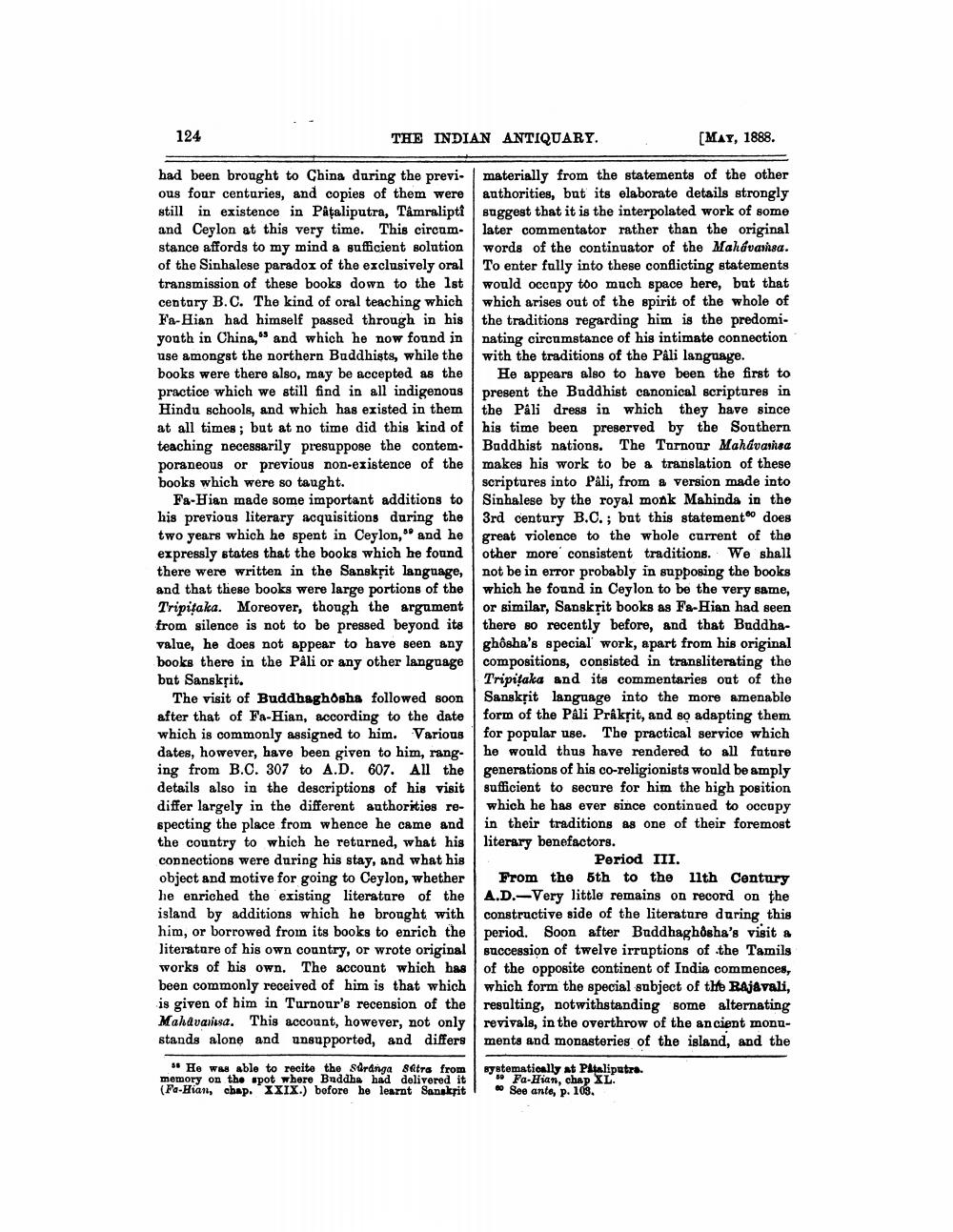________________
124
THE INDIAN ANTIQUARY.
[MAY, 1888.
had been brought to China during the previ- | materially from the statements of the other
ous four centuries, and copies of them were still in existence in Pataliputra, Tâmralipti and Ceylon at this very time. This circumstance affords to my mind a sufficient solution of the Sinhalese paradox of the exclusively oral transmission of these books down to the 1st century B. C. The kind of oral teaching which Fa-Hian had himself passed through in his youth in China, and which he now found in use amongst the northern Buddhists, while the books were there also, may be accepted as the practice which we still find in all indigenous Hindu schools, and which has existed in them at all times; but at no time did this kind of teaching necessarily presuppose the contemporaneous or previous non-existence of the books which were so taught.
authorities, but its elaborate details strongly suggest that it is the interpolated work of some later commentator rather than the original words of the continuator of the Mahavansa. To enter fully into these conflicting statements would occupy too much space here, but that which arises out of the spirit of the whole of the traditions regarding him is the predominating circumstance of his intimate connection with the traditions of the Pâli language.
He appears also to have been the first to present the Buddhist canonical scriptures in the Pâli dress in which they have since his time been preserved by the Southern Buddhist nations. The Turnour Mahavansa makes his work to be a translation of these scriptures into Pâli, from a version made into Sinhalese by the royal monk Mahinda in the 3rd century B.C.; but this statement does great violence to the whole current of the other more consistent traditions. We shall not be in error probably in supposing the books which he found in Ceylon to be the very same, or similar, Sanskrit books as Fa-Hian had seen there so recently before, and that Buddhaghôsha's special work, apart from his original compositions, consisted in transliterating the Tripitaka and its commentaries out of the Sanskrit language into the more amenable form of the Pâli Prâkrit, and so adapting them for popular use. The practical service which he would thus have rendered to all future generations of his co-religionists would be amply sufficient to secure for him the high position which he has ever since continued to occupy in their traditions as one of their foremost literary benefactors.
Fa-Hian made some important additions to his previous literary acquisitions during the two years which he spent in Ceylon," and he expressly states that the books which he found there were written in the Sanskrit language, and that these books were large portions of the Tripitaka. Moreover, though the argument from silence is not to be pressed beyond its value, he does not appear to have seen any books there in the Pâli or any other language but Sanskrit.
The visit of Buddhaghosha followed soon after that of Fa-Hian, according to the date which is commonly assigned to him. Various dates, however, have been given to him, ranging from B.C. 307 to A.D. 607. All the details also in the descriptions of his visit differ largely in the different authorities respecting the place from whence he came and the country to which he returned, what his connections were during his stay, and what his object and motive for going to Ceylon, whether he enriched the existing literature of the island by additions which he brought with him, or borrowed from its books to enrich the literature of his own country, or wrote original works of his own. The account which has been commonly received of him is that which is given of him in Turnour's recension of the Mahavansa. This account, however, not only stands alone and unsupported, and differs
He was able to recite the Saranga Satra from memory on the spot where Buddha had delivered it (Fa-Hian, chap. XXIX.) before he learnt Sanskrit
Period III.
From the 5th to the 11th Century A.D.-Very little remains on record on the constructive side of the literature during this period. Soon after Buddhaghosha's visit a succession of twelve irruptions of the Tamils of the opposite continent of India commences, which form the special subject of the Rajavali, resulting, notwithstanding some alternating revivals, in the overthrow of the ancient monuments and monasteries of the island, and the
systematically at Pitaliputra. Fa-Hian, chap XL. eo See ante, p. 103.




